Samsung Q80B Reviewed at $1,299.00 (55")
Product Name: Samsung Q80B
Product Description: 2022 4K QLED TV
-
Design - 9.1/10
9.1/10
-
Video Quality - 8.5/10
8.5/10
-
Ports & Connectivity - 9.4/10
9.4/10
-
OS, Apps and Features - 9.5/10
9.5/10
-
Price / Quality - 8.5/10
8.5/10
Summary
Reviewed at $1,299.00 (55″)
Pros
- Good brightness
- Extremely low input lag
- Wide viewing angles
- Four HDMI 2.1 ports
Cons
- Mediocre local dimming
- Very low contrast
- No Dolby Vision
- Audio capable only for casual use
Cheapest Places to Buy :
*We are a reader-supported website. When you buy through links on our site, we may earn a small affiliate commission at no extra cost to you. Home Media Entertainment does not accept money for reviews.*
A few days ago we had the opportunity to try out the cheapest of the QLEDs Samsung has on offer for 2022 and for now we will stay in QLED land as we have another of their models to try out. To our disappointment we saw that the Q60B was not all that different from what we got in 2021 and so in our Samsung Q80B review we are curious to see if this is more of the same or did Samsung will manage to surprise us this time.
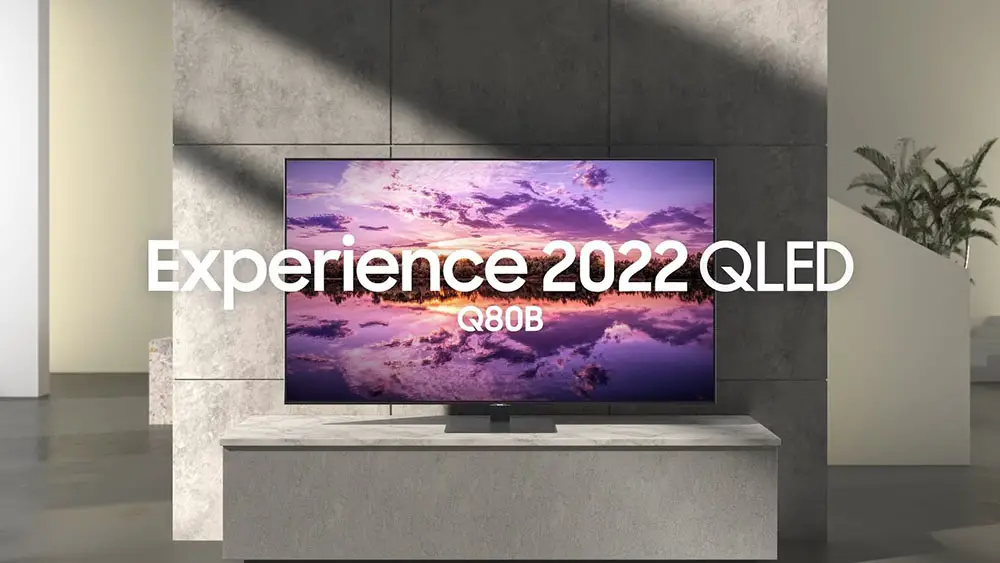
With the newer Neo QLED models it is evident that QLED is taking a backseat as Samsung slowly scales down the number of sizes and models in this lineup. In 2022 we have three models left, with the Q80B now being the top of the line, the Q70B the mid tier unit, and the Q60B the more budget friendly one. In terms of specs the Q80B once again doesn’t look all that different from the Q80A but there is one major change that we noticed right away and we will talk about in more detail shortly.
So going over the specs real quick the Q80B will come in five different sizes from 50″ up to 85″ and will be using a 100/120Hz ADS panel which is similar to IPS structure. It will be using a Full Array backlight with local dimming (FALD) and processing duties are handled by the Quantum Processor 4K. It will support HDR10+, uses the Object Tracking Sound audio system and utilizes the new Tizen 2022. The biggest difference in 2022 are the four HDMI 2.1 ports available compared to just one last year.
If you are a gamer having four HDMI 2.1 ports is really a game changer. One was good but very limiting if you have a lot of gaming devices to connect. We don’t see any other major changes in the Q80B so we will have to dig deeper to see what else the new 2022 release has to offer. So without further delay let’s start our analysis.
Design
In terms of looks and design the Q80B is extremely similar to the 2021 Q80A and the only minor difference seems to be their overall thickness.
In general the Q80B is a really nice TV featuring thin black borders that we measured around 0.4″ (1 cm). The TV’s overall thickness is very good although the inclusion of a FALD system at the back adds a bit of depth. But even as such the Q80B manages to be thinner than its predecessor as we measured it at 2.1″ (5.4 cm) making it almost a whole centimeter thinner.
Design wise the Q80B is using exactly the same shell as the Q80A and Q80T as we failed to distinguish any differences between the two. The frame, the stand and the back side are all like for like.
The back side comes with the same grooved design as the Q80A covering most of it’s surface. All ports are grouped together on the left side in a special inset with sideways orientation that can definitely help with cable management if you want to place in on a wall. On the right side we only find the power connector while on the bottom we get special grooves in order to drive the cables to the central stand. Lastly we get holes for the VESA wall mount. The entire back is made out of plastic which is the preferred material in most cases.

The Q80B seems to be using the same pedestal-style stand of the Q80A which looks pretty nice and is small enough so you can place the TV even on small furniture. Obviously this kind of stand can cause the TV to wobble a little more than other types but is stable enough not to cause any trouble. The stand is using both plastic and metal and with it’s flat surface makes installation of a soundbar far easier than some other stands we have seen from Samsung recently. The back of the stand is hollow so you can pass the cables through it for a cleaner look.
As for its remote the One Remote that is included in the Q80B looks similar to the year before but with some minor design changes and is the same across Samsung’s entire 2022 lineup. It is still small and uses very few buttons as it relies on the TV’s UI for most of its functions. It is still using a rechargeable battery that can be charged either through a USB-C cable or from its solar equipped back side. The only difference we find this year is that the top side is now seamless while a fourth dedicated button for Disney+ has been added.
In terms of design and build quality the Q80B is not all that different from last year. Small changes in its overall thickness and slight design updates on the remote make it feel slightly better but these are minor and do not affect its use in any meaningful way.
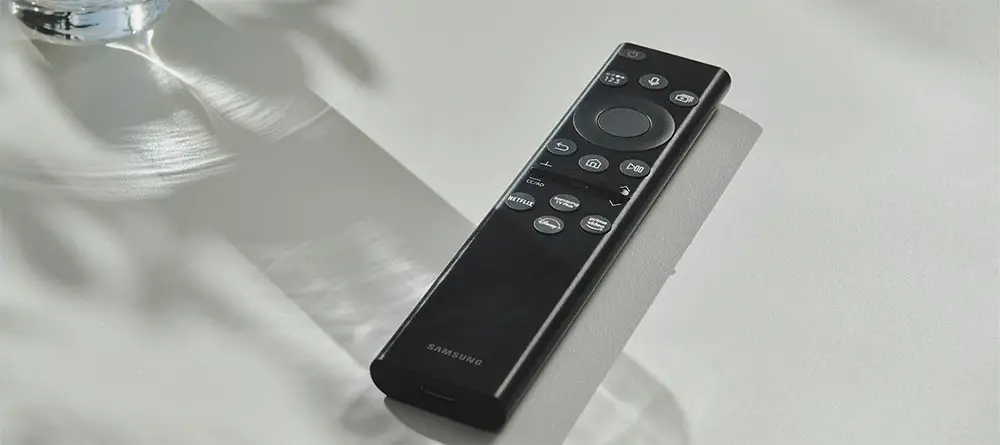
Video Quality
Processor technology used
As was the case last year, the Q80B is one of the two QLEDs, for one more year, that still use the Quantum Processor 4K with the other one being the Q70B. The third QLED this year, the Q60B, uses the lower performing Quantum Processor 4K Lite instead. With the arrival of mini LED the new Neo QLEDs are using updated chips so the Quantum Processor 4K went down the performance ladder to the mid tier QLED offerings.
As was the case in previous years there is no indication if the Quantum Processor 4K we have in 2022 is exactly the same chip we saw last year but it features the same AI enhanced capabilities as far as it’s image and audio is concerned. These include a specialized AI upscaling engine that is combining complex algorithms and a huge image database in order to classify aspects like textures and edges, and to optimally upscale each specific scene.
Also its Real Depth Enhancer feature automatically separates objects in the content from the background and creates 3D like depth in order to make the image even more immersive.
The Quantum Processors were always very capable at upscaling content and the Q80B proved to be more of the same. We tried out a selection of content from low resolution 480p to more high quality 720p and 1080p resolutions and the Q80B upscaled everything without much trouble and no visible artifacts. In general its behavior was similar to what we had previously seen in this category.
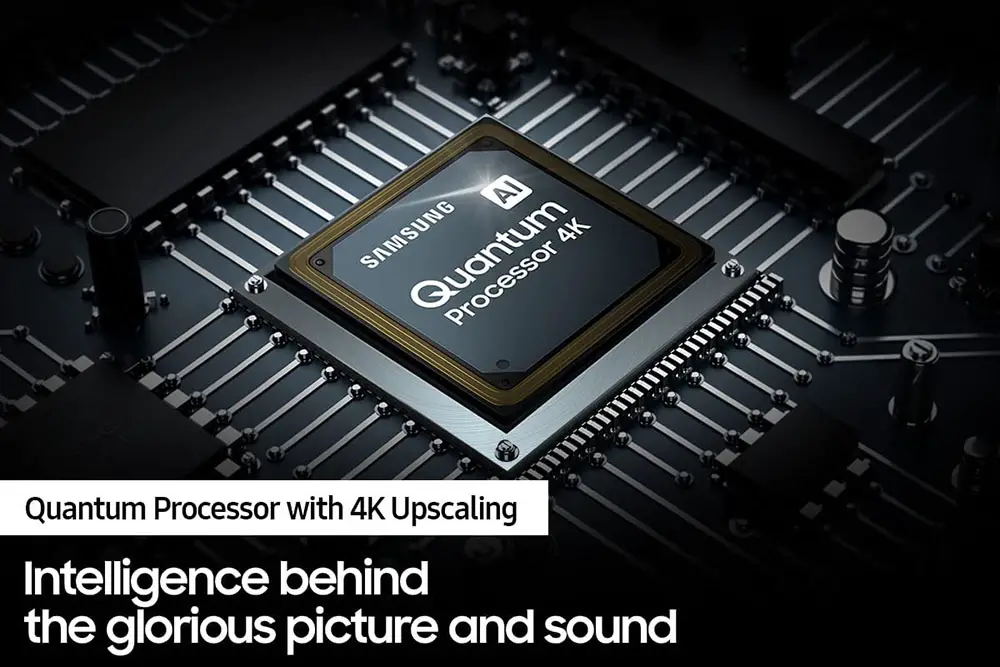
As always the better the source material the greater the result as the processor has more details to work with.
With such an advanced processor this TV also comes with Adaptive Picture which is a feature that analyzes the light conditions in your room and can calibrate the picture accordingly in order to provide you the best image quality for your specific situation.
But the Quantum Processor 4K is not only capable with images as it is used for some advanced audio enhancements also. As such the Q80B comes with Object Tracking Sound (OTS) audio system along with SpaceFit Sound which uses a special sensor on the TV to analyze your room and provide the best acoustic result possible.
Along with it special AI technology called Active Voice Amplifier (AVA) detects audio disturbances and enhances on-screen voices to deliver each bit of dialogue, loud and clear. We will talk in more detail about its audio capabilities in the dedicated audio section.
Lighting technology used
Until a couple of years ago FALD systems were considered the best choice when it came to backlights but with the arrival of mini LED they became somewhat of a mid tier choice now. As was the case in 2021, this year Samsung decided to use the FALD system in a single TV and this is no other than the Q80B showing how similar this one is to its predecessor, the Q80A.

A FALD system in order to perform good depends on two factors, the number of dimming zones available and how fast each zone can change it’s light output. The more dimming zones used the better and more accurate light control the TV has but also the higher the price goes, that’s why they usually scale the dimming zones number depending on the model. The effect on having low number of dimming zones can be seen when you see a very bright object on a completely dark background. If the TV has very few zones light will escape to the nearby pixels and create a visible halo around the object.
Also the light algorithms play a huge role as they control the response time of the various dimming zones. If the change is slower than it should be you will see what is called ghosting when a bright object moves very fast against a dark background.
The FALD backlight of the Q80B behaved in much the same way we were expecting it to. We did notice some major blooming in specific scenes where bright highlights were rendered in a completely dark background. Also the local dimming feature was not particularly efficient and its dimming zones were too slow to turn off and on as it was becoming visible when a bright object would pass from one zone to the next.
The Q80B incorporates only 48 dimming zones in total which are not a lot considering some top tier TVs with FALD backlights were using a few hundred zones before.
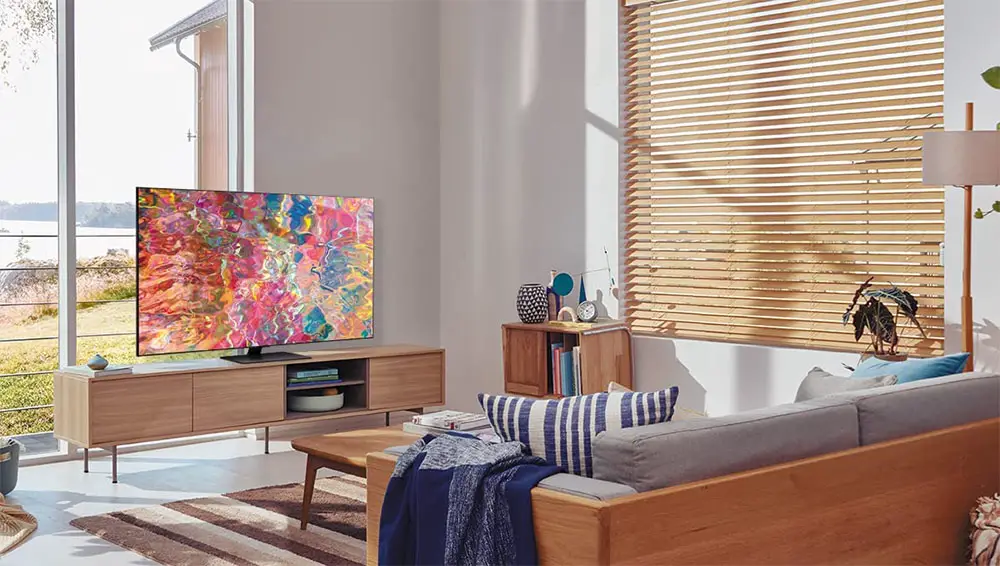
Also another minus of having a FALD system in the TV is that usually this adds slightly to the thickness of the unit as the FALD system is incorporated at the back of the panel. Thankfully the Q80B has been improved here as Samsung has managed to make this one even thinner than what the Q80A was.
The Q80B is basically the same here as the Q80A was before so no surprises.
Brightness / Contrast
Brightness is one of the most important aspects of any HDR TV nowadays as with HDR content the need for high brightness output is bigger than ever.
For our review we used the Movie mode and Warm 2 color tone along with Local Dimming set to High. In our SDR brightness test over a 10% white window we got 876 nits which is excellent when you are viewing SDR material. On our HDR brightness test over a 10% white window we got 842 nits of brightness which was really good and even though the TV failed to pass the 1,000 nits limit highlights were bright and very vivid.
From our measurements it seems that Q80B is slightly brighter in SDR but dimmer in HDR which is a strange overall behavior to be honest.

Brightness levels followed the EOTF reference values very close up to its slow roll-off point although there were some minor deviations.
In terms of contrast the Q80B comes with a ADS panel (for the 55″ unit we had for testing), which basically is a panel very similar in structure to IPS ones, and as a result contrast ratio suffers a lot. Blacks look very greyish and local dimming seems to do little to improve on that. This is a problem particularly in a dark room where the greyish blacks are far more visible. If you will be using this TV in a bright room then this problem will not be so evident.
In pure numbers the Q80B seemed to have even worse contrast compared to the Q80A although with the Local Dimming turned on both had very close values.
Keep in mind that the 50″ and 85″ sizes use VA panels and as a result they should behave differently here.
The Q80B performed very similar to the Q80A here. Its low number and slow response dimming zones cannot do much to hide blooming and ghosting while its low contrast made blacks look more like greys in a dark environment.
Viewing angles
The Q80B is using an ADS panel which is some type of IPS panel and this in general means good things in terms of viewing angles. Samsung mentions that the Q80B is using Wide Viewing Angle technology as the one found in some previous QLED models, which by the way is not the same as Ultra Viewing Angle that we see in some top premium units.
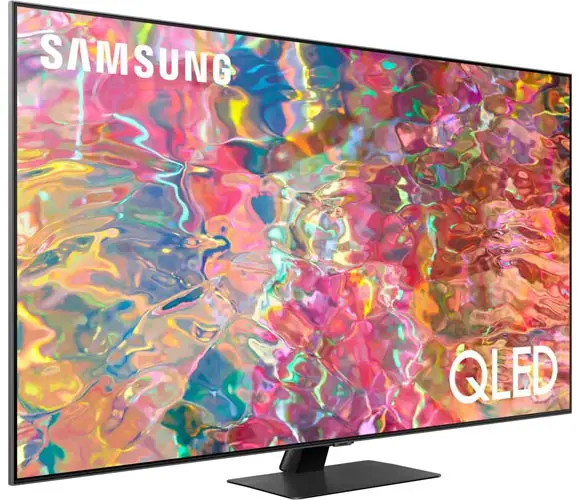
From what we observed we would say that a maximum of 40 degrees angle was acceptable with little degradation in overall image quality. Anything more and the image looses a lot in terms of brightness, colors and black levels. So if you are considering to use this as a family TV you shouldn’t have any problem with various viewing positions.
Again, the 50″ and 85″ should fare worse here as the VA panels they come with are not so good when viewed from such extreme angles.
HDR support
HDR support is another area where Samsung hasn’t changed anything for 2022. As such we get the most basic HDR10 that is required for 4K UHD playback, there is HLG that is used mainly for broadcasting along with the newer HDR10+ which is the most advanced HDR protocol that uses dynamic metadata in order to provide the best image quality on a frame by frame basis, similar to what Dolby Vision is doing.
The Q80B comes also with HDR10+ Adaptive and HDR10+ Gaming. HDR10+ Adaptive uses its AI engine to analyze the viewing environment, including the lighting, brightness and even reflections using the sensors equipped on the TV. The results are then incorporated into the dynamic metadata, and then through four further steps, the brightness and contrast of a scene are optimized. This way you can view HDR10+ movies and television programs in various environments at home.
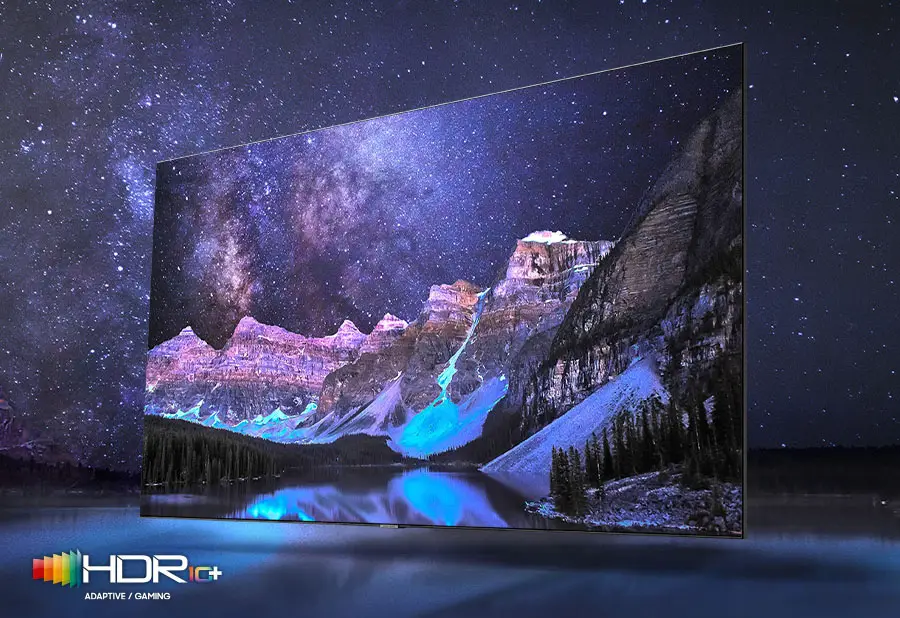
Samsung continues to say no to Dolby Vision and this surely is hurting their entire lineup. Samsung remains very confident supporting HDR10+ instead but in our opinion this is a pointless conflict and all manufacturers should embrace all HDR formats instead of pushing consumers to choose by brand because of this.
Color coverage
The Q80B being a QLED uses Samsung’s special Quantum Dot layer in order to display more vivid and lifelike colors. Samsung claims 100% coverage of the DCI-P3 color space but you should never take these numbers literally as they are mostly used for marketing purposes. Real numbers usually deviate a lot from these claims.
According to our measurements the TV has about 91% coverage of the DCI-P3 color space which is great for this mid-tier category even if it cannot reach the 100% claim of Samsung. On the wider REC.2020 color space we got a coverage of 68% which is still good enough even if not as good as some other releases.
In total the Q80B performed marginal better than the Q80A but the difference was very small to be considered noteworthy and could very well be due to the use of a different panel.
Before calibration the Q80B had good color accuracy but not without some issues. White balance needed adjustment and a few colors had values above the DeltaE limit of three. Both of these were corrected after calibration.

Color gradients were very good although some banding was visible in some darker shades. There is also a Noise Reduction function in case banding is bothering you but you are going to loose some fine detail if enabled.
Motion performance
We move on to our next part which includes our motion performance tests. It seems that the Q80B hasn’t changed anything here from last year as it comes with a 100/120Hz panel along with a backlight dimming frequency of 960Hz which is exactly the configuration we saw in the Q80A. Having such a high frequency ensures that flickering is completely invisible but this also depends on the picture mode you will be using as in some of the them the frequency drops to 100/120 Hz.
Obviously we also get motion interpolation which once again is named Motion Xcelerator Turbo+. The Q80B was capable at removing judder but we did notice various artifacts during fast camera movements while interpolation was active at all times even when there were static images or slow camera movements. Some stutter was also noticeable during low frame rate content which could only be eliminated by enabling motion interpolation.
Enabling motion interpolation can be done, in the same way as with all other Samsung models, by going in the Picture Clarity settings in the menu and by adjusting the two sliders for blur or judder. Keep in mind that very high values in the sliders and the “Soap Opera Effect” will appear so if you want to improve motion but you hate the SOE effect keeping minimal values in these two sliders, like 1 or maximum 2, is your best bet.

Black Frame Insertion (BFI) is also available as usual which can be enabled in the menu with the LED Clear Motion option. BFI is a technique that inserts a black frame in between two individual frames in order to smooth out motion. Although the end result is very good, it has a couple of side effects. First due to the black frames, brightness takes a visible hit while due to the lower frequency used which can be either 100/120Hz or even 50/60Hz some flickering may become noticeable.
Overall we cannot say that the Q80B behaved vastly different from last year. It showcased solid performance although not without its issues especially with heavy action scenes.
Input lag
The last few years manufacturers push the envelope more and more when it comes to their TVs input lag performance and we have reached a point where we get amazing low values that can make these TVs excellent for gaming purposes.
According to our measurements the Q80B measured an average of 10.2ms input lag in both 1080p and 4K resolutions at 60Hz with the use of Game mode. At 120Hz we measured 5.8ms in both 1080p and 4K resolutions which is amazing and will result in a completely satisfying gaming experience.
With such low figures, gaming can really be a pleasure but in order to get such a low value you have to keep in mind that you need to use the available Game mode as outside that the input lag will greatly increase to around 81.2ms which can still be used in slow paced offline games but it is too much for online gaming that requires blazing fast response times.
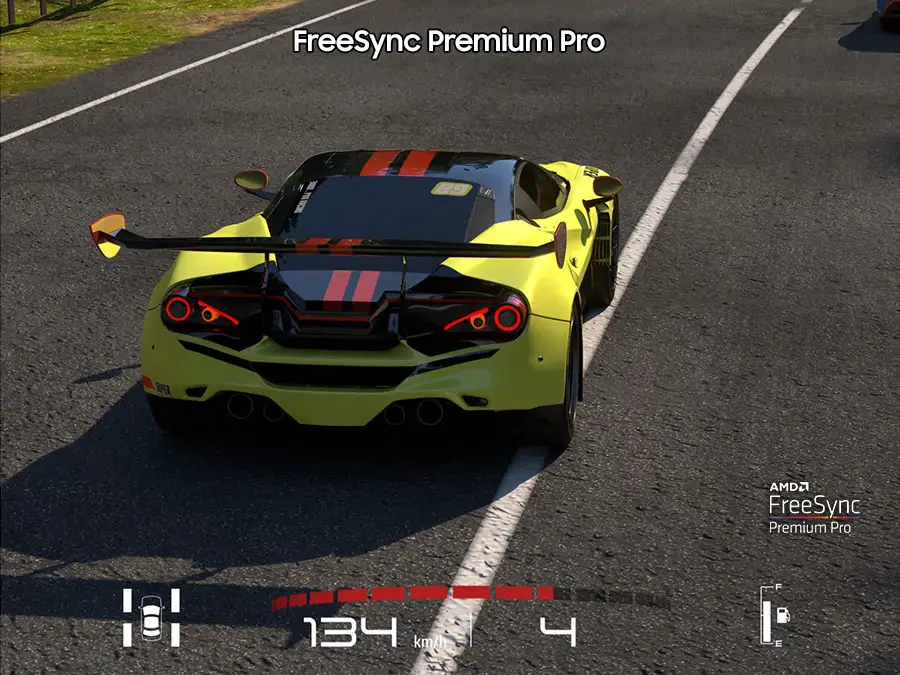
We should also not forget to mention that the TV supports Auto Low Latency Mode (ALLM) that can be used with any devices that support that like the PS5 and Xbox consoles and can greatly benefit users. Once again we get HGiG Mode which is HDR Gaming Interest Group’s technology that ensures you enjoy HDR games the way that their creators and developers intended.
The Q80B, as with many Samsung TVs this year, also supports FreeSync Premium Pro which can vastly improve your gaming experience if you have a device that also supports AMDs solution. Along with it we get support for all other VRR technologies including HDMI Forum VRR and NVIDIA G-Sync which can be enabled from the new Game Bar 2.0.
We tried to play a few rounds of F1 2021 with our PS5 connected to the Q80B and we had practically zero problems during our sessions. Everything was smooth with fast responses and no obvious delays making the Q80B an excellent gaming offering.
Image quality impressions
Overall we cannot say that the Q80B is better or worse than last year’s Q80A. There are some areas where the Q80B seems to be slightly better like SDR brightness and color coverage but then you get worse native contrast and lower HDR brightness.
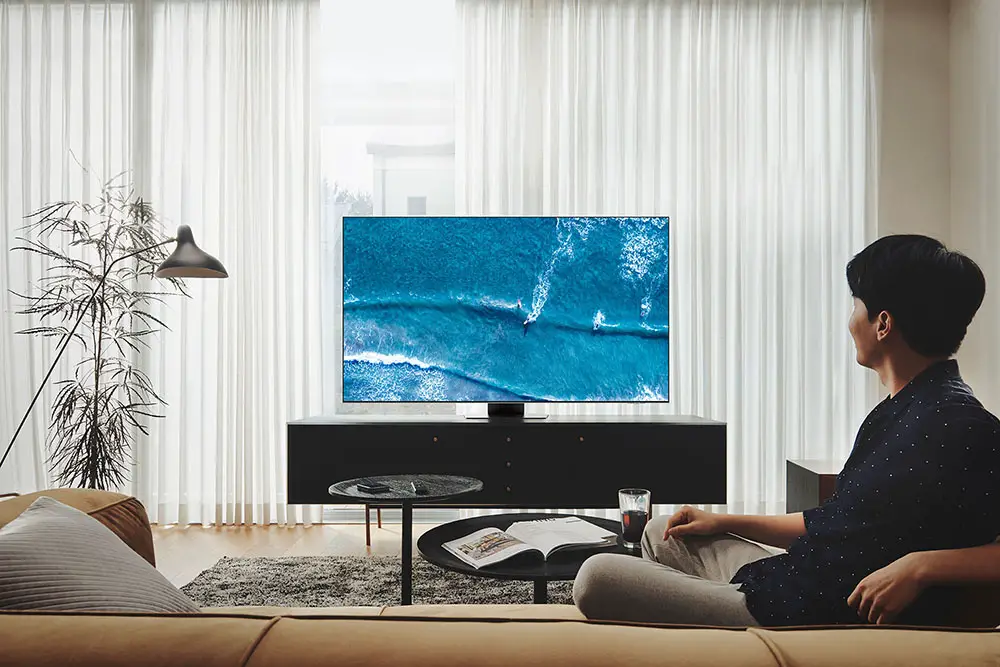
Other areas like upscaling, motion performance, input lag and viewing angles they were both very close and so in the end we cannot suggest one over the other. We will consider them equal and if it is image quality you seek then both of them will do almost the same.
Audio Quality
If there is one area that manufacturers are still struggling with after so many years is in the audio department. These ultra slim TVs simply don’t have the space required to equip them with audio systems capable at offering more immersion and better sound. We have seen most TVs lately incorporating various techniques and features but most of them are mostly software based and the end result is not much better than we could hope for.
It’s been a couple of years now that Samsung has developed their own audio system for many of their top tier and mid offerings called Object Tracking Sound and as of 2021 there are four variants of this system depending its capabilities. We have the OTS Pro, OTS+, OTS and OTS Lite and for the Q80B Samsung has once again used the OTS variant. In essence the Q80B is featuring the exact same audio system the Q80A and Q80T had before.
So what we get is a 2.2.2 channels audio system with a power rating of 60 watts in total which is sufficient for casual viewing. The difference compared to the OTS+ is that the latter uses 4.2.2 channels instead making the sound be more accurate when tracking what is on screen. Just keep in mind that the 50″ size comes with OTS Lite which is less capable than the OTS we have here in the 55″ model.
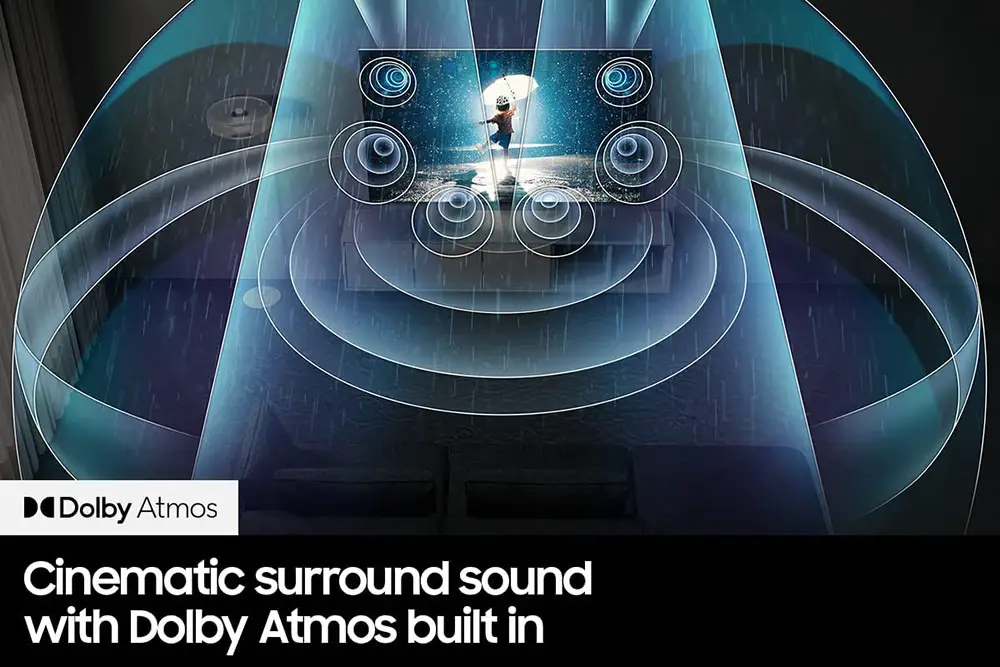
Trying out the audio capabilities of the Q80B didn’t show any meaningful differences from what we remembered in our Q80A testing. Overall output is good enough for casual use including sports, news broadcasting and talk shows but in terms of surround immersion and cinematic output it surely falls short of expectations.
The TV supports Dolby Audio but even with a system like OTS you shouldn’t expect much out of it. If you want something better you will certainly need a dedicated audio system or at least a soundbar with surround speakers. Dolby Atmos can be passed-through the included eARC to some Dolby Atmos soundbar or dedicated sound system in this case.
DTS support is completely absent once again this year as it is not only missing from native support but it cannot also be passed-through from any of the available ports which is rather disappointing. And this applies for all Samsung TVs, either low cost or top tier premium ones.
The Q80B also comes with some added features we saw in the Q80A before. The first one worth mentioning is called Adaptive Sound+ with which the TV analyzes the content being played and for each scene can identify and render the best sound type. This whole process starts by separating and classifying audio input signals. Key characteristics are then pulled out and rendered to best suit the scene.
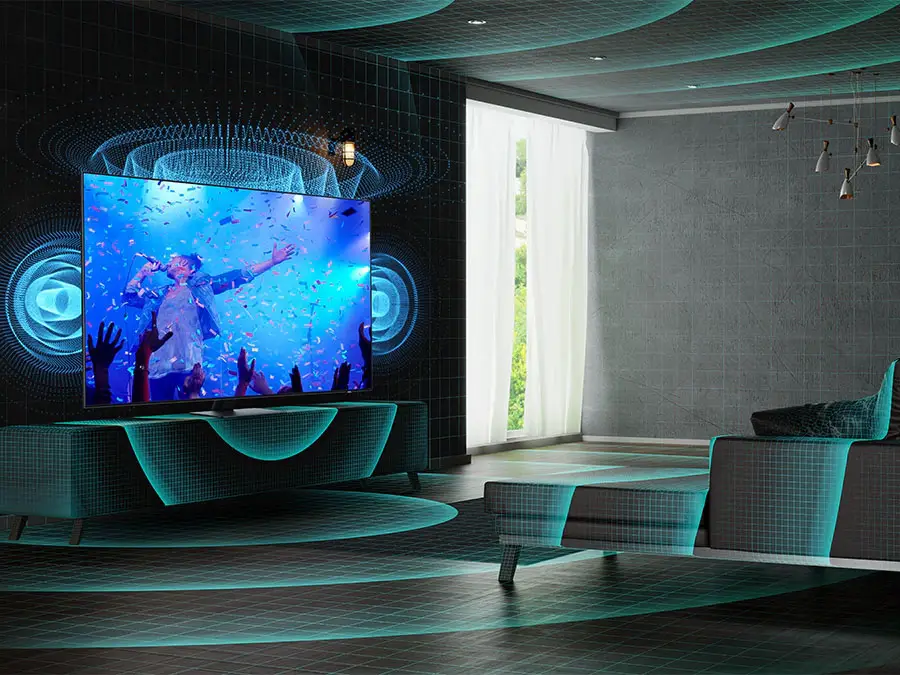
Another feature is SpaceFit Sound along with Active Voice Amplifier (AVA). With the help of spatial analysis the TV can adapt to the different acoustics of each room. This is done by sending inaudible signals that analyze your room and can optimize the sound accordingly. And by using AVA the TV can detect environmental noise and enhance the voice output of the content you watch for a more pleasant viewing experience.
Lastly we get Q-Symphony which is a feature that you can use to combine the TVs audio system with an appropriate soundbar that also supports that. This way the audio will be synced and output from both devices for an even more immersive audio experience. Samsung has released a whole lineup of soundbars that support Q-Symphony in case you are thinking of getting one.
In terms of audio quality and performance there is no much to say. The Q80B comes with the same characteristics, features and overall output of previous Q80 models. If you are planning to use the Q80B for movies a dedicated surround system should be a must or at least consider a good performing soundbar.
Ports and Connectivity
Looking at the ports layout of the Q80B we don’t find any visual differences to last year. Everything is placed in exactly the same way with all ports looking sideways and only the power port being separated from the rest to the right.
Starting from the top right we find two USB ports, a single digital optical output, four HDMI ports, an Ethernet port for wired connection to your local network, an Ex-Link port and the usual antenna/cable connector.
The major update in the Q80B is that all four HDMI ports are version 2.1 with 48Gbps of bandwidth due to the use of Samsung’s own SoC unlike Sony that still has to rely on MediaTek chipsets with all the problems these have. This is a major change to the single HDMI 2.1 port the Q80A had and surely if you have multiple gaming devices the Q80B offers a lot of freedom that was not possible before as last year you had to go for a more expensive model to find four HDMI 2.1 ports available.
Having HDMI 2.1 means that the Q80B supports all new and old features including 4K@120, ARC, eARC, ALLM, VRR, G-Sync, FreeSync Premium Pro, HFR and HDMI-CEC.
One thing that doesn’t seem to change is the Ethernet port that for one more year will only support up to 100Mbps which is a real shame but not entirely surprising given the fact that all manufacturers still include 100Mbps adapters in their TVs. We don’t believe that upgrading these ports to Gbit speeds would up the cost so much and with streaming requirements increasing every single year this change should have been made some time ago. Let’s hope that manufacturers will take notice of this sooner rather than later.
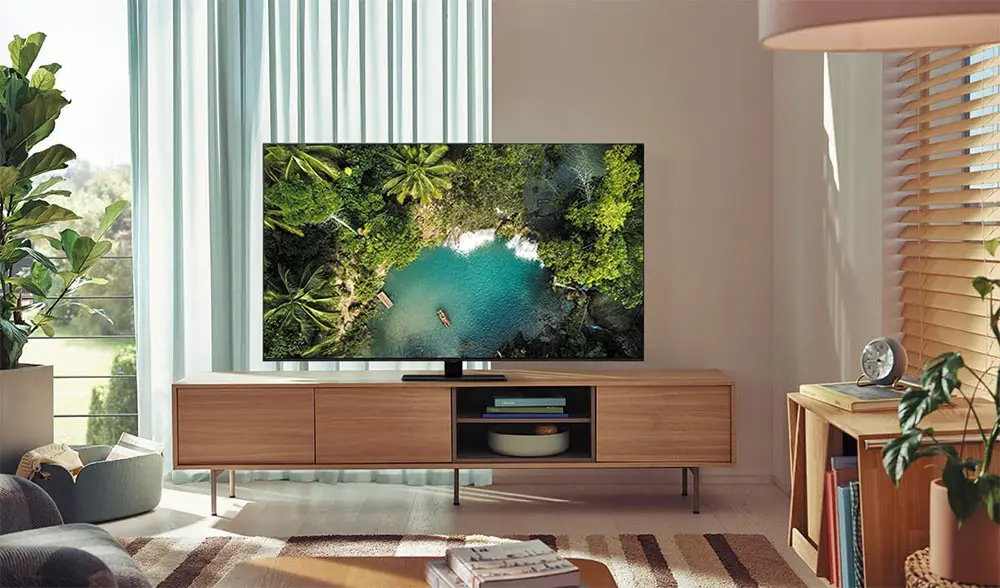
And since we talked about online the Samsung Q80B comes with built-in wireless capabilities as it supports WiFi 5 (802.11ac) along with Bluetooth which in 2022 has been updated to version 5.2.
OS, Apps and Features
Being a Samsung TV means that for its OS we find the usual Tizen platform which has been updated to its 2022 version and the Q80B is no different from what we saw previously in our Samsung S95B and Q60B reviews. It seems that Samsung decided to follow Google and LG and made the new Tizen occupy the whole screen instead of being a tile based row at the bottom of the screen, exactly as Google TV and webOS are this year.
It seems that smart TV platforms opt for a more personalized experience and as such the new Tizen 2022 tries to provide you with options that are tailored for your viewing habits. As such there are personalized ads, recommendations based on your viewing patterns both for streaming services and broadcasting channels and even shopping suggestions.
If you have used Tizen before, the new version may feel a bit chaotic at first. This was the same with Google TV and webOS and certainly you will need to spend some time with it to get your bearings. But once you get the hung of it, it is easier to navigate than it may seem.
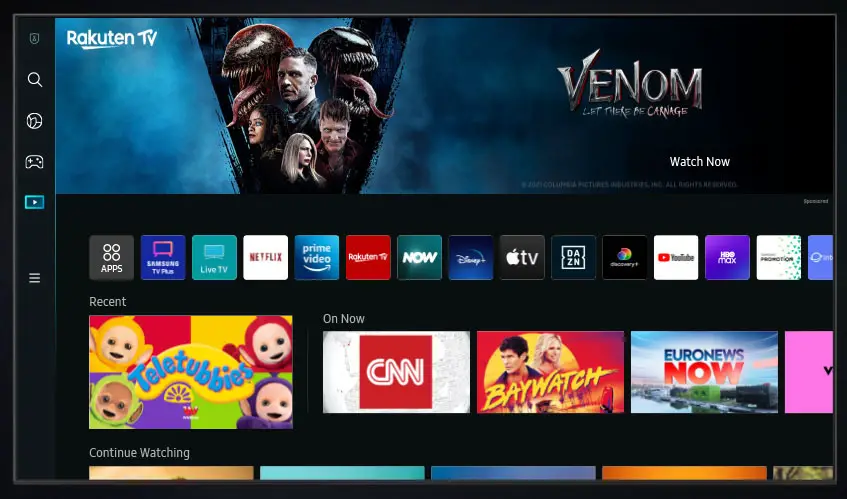
The new Samsung Smart TV Hub is separated in different sections and it allows you to navigate easily through all of them. At the left of the screen there is a single column with a few central selections including Media and Ambient while the rest of the screen is divided in rows with streaming services, apps and other functions and features available.
Having tried both the latest Google TV and webOS we can say that the new Tizen is not all that different. Obviously the layout is tailored to Samsung’s needs but in essence it offers the same thing. Navigation was smooth enough and jumping from one app to the other was relatively fast and with no obvious lags or delays.
Except from the visual overhaul the new Tizen comes with a few updates although fundamentally it offers the same kind of functionality we had experienced last year.
The Super Ultrawide GameView & Game Bar that was introduced last year makes a return but now it is called Game Bar 2.0 and got an update along the way. This is an on-screen menu that lets you make real-time adjustments to screen ratio, input lag check, FPS, HDR, wireless headset settings and more. This can be a really handy feature to gamers as you don’t have to mess with menus every time you want to check on a specific setting. With this quick feature you have everything in front of you with the click of a button.
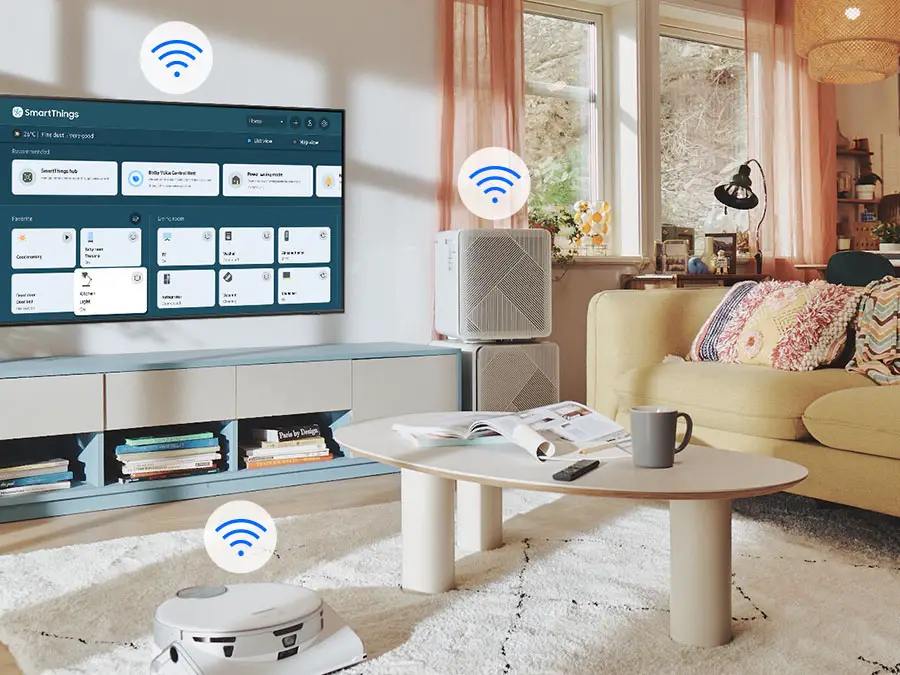
When it comes to content the Tizen platform is famous for it’s enormous support from developers. The Q80B offers practically all known services and platforms you can think of with Netflix, Apple TV, Disney Plus, Youtube, Amazon, Hulu, Rakuten, Demand 5 and BBC iPlayer just a few of the big names available. There is also Samsung TV plus which offers hundreds of subscription-free channels to choose from. Many of these services can playback in both 4K with HDR like Netflix and Amazon but this is very much app dependent.
A function that has been retained from the last few years is SmartThings integration. With it you can make your TV the central hub of all your smart houses devices. These can be lights, electronic locks, alarms, vacuum robots, thermostats and everything that supports the SmartThings platform.
Obviously another feature that could not be missing is voice control. It seems that Samsung is really trying to market their own Bixby service but even if you are not very fond of that there is Amazon’s Alexa or Google Assistant to choose from. While if you are an Apple guy then don’t get disappointed as there is also Airplay 2 support and you can use Siri through it for your voice commands. Unfortunately while Airplay is available HomeKit is not.
Another feature that was introduced a couple of years ago and seems to be a standard now is Multi-View and although at it’s core it’s not something entirely new Samsung took it a step further. Multi-View is basically a more advanced screen mirroring and with it instead of just simply projecting the screen from your mobile device on the TV you can choose to have two screens showing both TV content and what your mobile device shows.
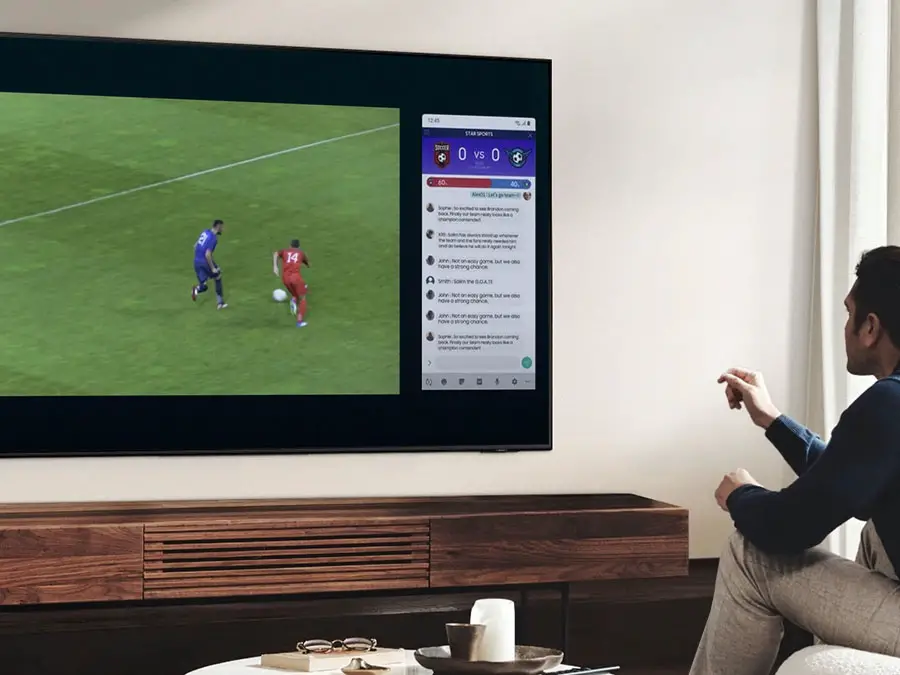
In addition to Multi-View there is also Tap View and with it you can mirror your phone on your TV with just a tap to continue enjoying movies, music, and apps on the bigger screen within seconds.
Another returning feature is Ambient Mode+ which is a slightly enhanced version of the Ambient Mode we get in many Samsung models for the last few years. With the plus version now except from the ability to display various images on the TV when not in use it can also project various information including weather updates, news headlines, photos and music.
Samsung Health is another returning feature from last year. Last year with the coronavirus pandemic many people were staying indoors so Samsung thought that exercise at home would be on the rise. So many of their TVs came with Samsung’s program in order to stay in shape. It seems that Samsung liked it so they kept it in for another year.
The Q80B comes with the complete feature set that Tizen 2022 has to offer. The new full screen layout takes a bit of time to get used to but other than that you get an amazing smart platform for all your needs.
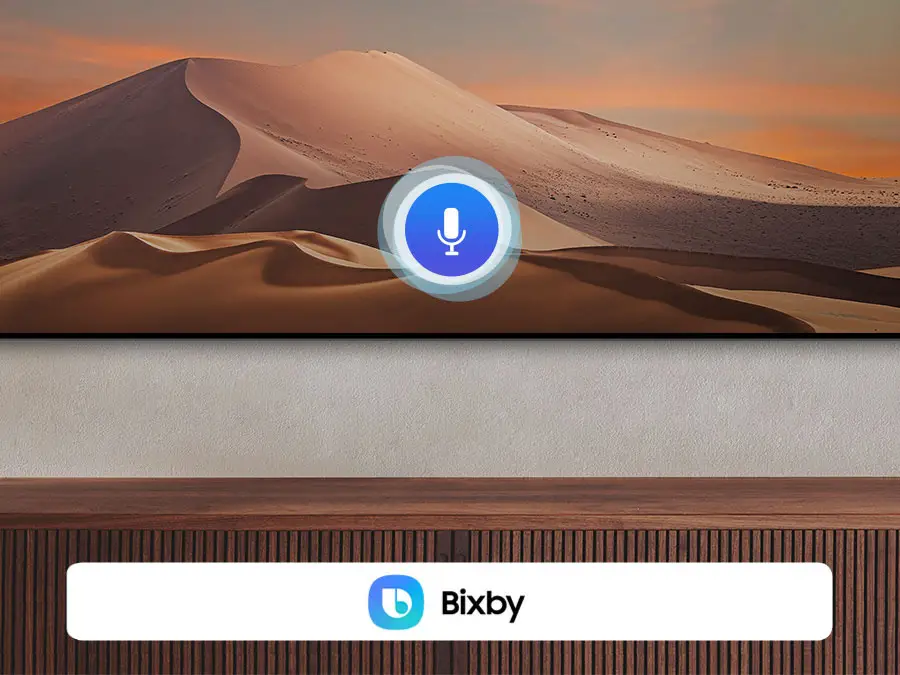
Final Thoughts
The Q80B is another QLED in 2022 that it is not all that different from last year’s release. But at least compared to the new Q60B that felt like a Q60A with a new Tizen installed the Q80B actually comes with with at least one major upgrade and this is no other than the use of all four HDMI 2.1 ports compared to just one last year.
Everything else seems to be very similar or exactly the same as last year. The Q80B proved to be a very capable TV at upscaling all kinds of content, color reproduction and accuracy were good enough, viewing angles were nice, input lag was great and motion performance was solid. Add the new Tizen and full HDMI 2.1 support along with all the gaming features available and the Q80B is really a very interesting 2022 offering.
On the other hand the TV has all the same problems we saw last year. Contrast was mediocre with blacks appearing more greyish, its FALD backlight was not capable enough with halos appearing around bright objects in dark backgrounds and its dimming algorithm had very slow reaction times. No Dolby Vision will continue to hurt all Samsung releases while its audio is only good for casual use and nothing else.
In the end the Samsung Q80B feels more like a filler release. It surely will find its place in the consumer market as it is the only Samsung TV this year with a FALD backlight and it bridges the gap nicely between the higher tier Neo QLEDs and the lower performing QLEDs under it. If the price is right then it is a TV definitely worth looking at.
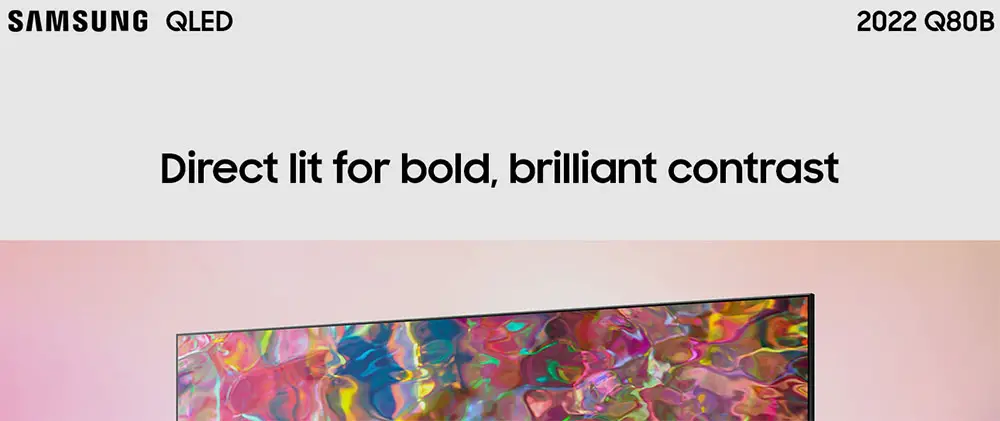
For more reviews you can check our dedicated 4K LED LCD TV reviews list or even look at our Product Reviews Table where you can find the brand and specific product you are looking for.
Cheapest Places to Buy :
*We are a reader-supported website. When you buy through links on our site, we may earn a small affiliate commission at no extra cost to you. Home Media Entertainment does not accept money for reviews.*
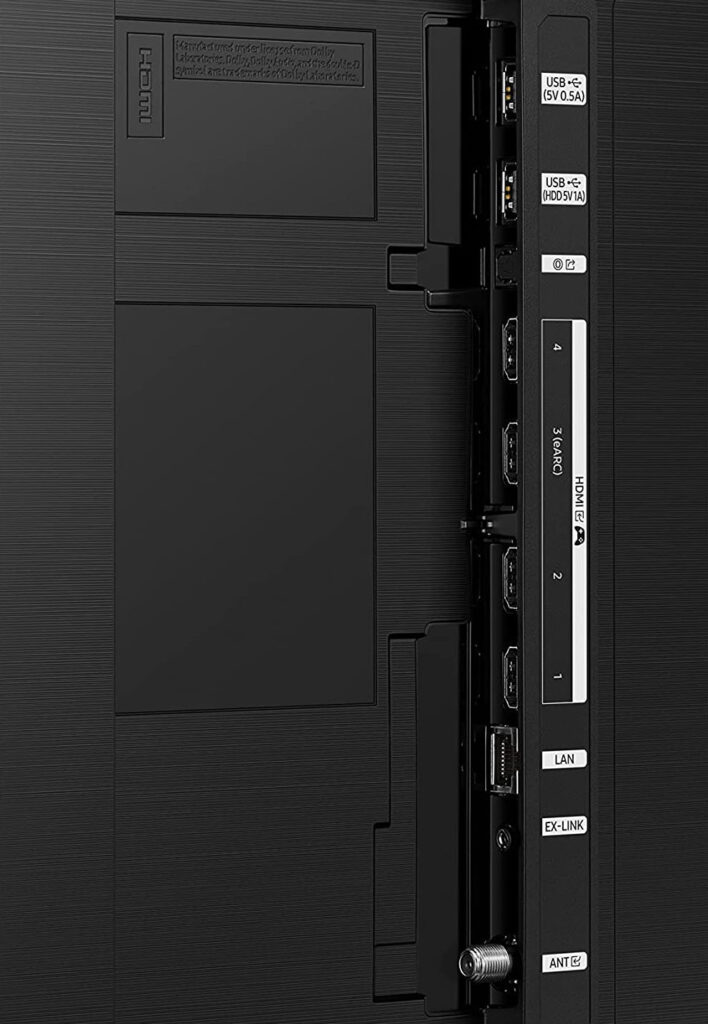
I was looking for a new TV and the Q80B seems to be my sweet spot. I have seen some TVs with Edge LED and didn’t like them much so the Q80B is my only option with a FALD. Anything above this is way out of my budget.
But how does the TV fare with direct sunlight? Does it have anti reflection? Because I play game in a fairly bright room and light can be very distracting.
Other than this all the features it has are great for my needs.
Its anti-reflection capabilities are ok but not great. You will need to use at least a curtain to somehow minimize the problem. There is no other way around it.
I have always been a huge fan of Samsung and the quality they provide, But sometimes they claim to have differences in the newer models even if it’s the same as the previous ones. That’s why I like to see reviews on the latest models first before I even think of buying a new tv.
I like the pedalstal-stand so they can continue using them in my opinion. Thanks for sharing this information with me.
I think what is going on with these yearly releases affect all manufacturers, not only Samsung. Obviously in the lower tier categories the specs don’t change as dramatically as it the top premium category. Some tech will carry over but most advances are happening at the top and to a less degree at the middle and low section. This is why many low cost TVs feel more like re-releases than actual new models.
Hey, nice post! Thanks for sharing this information. Keep sharing!
You are welcome Ali.
Can you please do a review for Samsung Q70B?
We are going to test the Q70B at some point, I just don’t know when as we have a few other models in priority. Keep checking back in the near future.
How does the 55 inch 80b compares to the 55 inch 80a. Thanks
They are very similar Dan. The only major upgrades the Q80B has over the Q80A are the four HDMI 2.1 ports (compared to just one in the Q80A) and the updated Tizen. Everything else is very similar or entirely the same.
Hello,
Thank you for this clear and precise article.
Too bad no homekit so I’m going to LG
rodgers
Hello Rodgers. I translated your comment into English so everybody can understand. Please try to comment in English next time. Unfortunately Samsung TVs do not support Homekit. But there are some solutions to this if you look on the internet. But officially no, you will not find it.
Hey Stratos, amazing article direct and very informative. I’m thinking of buying the samsung Q70B but then I came across the Q80b and now I’m confused on which one to buy. The price difference between them is between 250-300$ is it worth it? I mainly use the tv to watch series and movies, second main use would be connecting it to my mac and the final and least is for gaming maybe once a week. whats are the main key differences between them because I couldn’t find anyone comparison online between the exact models (B).
Hey there. You could simply check our article about Samsung TVs for 2022. We have comparison tables for all models and you can easily see their main differences.
Their main difference is their backlight. The Q80B uses a FALD system while Q70B uses an Edge LED.
What are the direct competitors to 55″ Q80B at similar price point?
The question I have to ask is what is the price of the Q80B at the current moment. The TV had a price tag of $1,299 for the 55″ size when it came out last year. So this surely does not apply right now with the new 2023 models becoming available. So if you can tell me what price you can get it for I may be able to give you some suggestions.